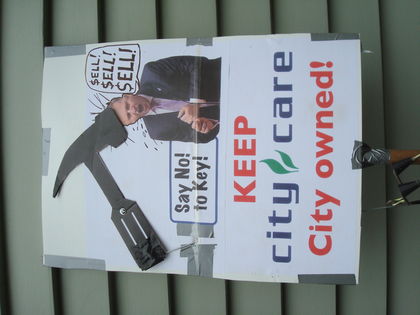Hard News: Footpaths, not manifest destiny
85 Responses
First ←Older Page 1 2 3 4 Newer→ Last
-


My first ever animated gif !
- a bit dodgy I know but now I get the idea – could be hours of fun…
…this was just to recreate the visual effect of the mop-handle-powered animated placard I waved about with approx 20 others at yesterday’s Save City Care picket(2nd pic - I know it's side on, but opens right way up - bloody computers!)
an informal survey of the ‘tooters-to-passers’ ratio shows an overwhelming number of the passing populace support keeping City Care in City control… -
Steve Todd, in reply to
Hello, Keir--
My computer died on Tuesday and is now on its way to Auckland to be fixed. I'm posting this from a cybercafe.
The “communities of interest” section of the Local Electoral Act (section 19T “Requirement for effective representation …”) is an FPP holdover from section 101L of the Local Government Act 1974 (as amended in 1989 – Local Government Amendment Act (No 2)).
The expression “communities of interest” has never been defined (as far as I can tell). Coming into existence as it did in 1989 it seems to me it was simply interpreted as meaning "(contiguous) suburbs” or “localities”, that sort of thing. Consequently, the ward system, introduced in 1986 to overcome distortions in
representation, which take account of communities of interest, merely ensures that separately-defined geographical areas, and by extension, the people within them, are represented.Basically, the concept of “communities of interest” is an FPP construct that becomes completely irrelevant with STV at-large (or in large wards). In political terms, especially with STV, the greatest indicator of “community of interest” is voter intention. As long as multiple-FPP is retained, the presence of wards will never correct distortions in the representation of the people themselves, by ensuring that as many electors as possible are represented by a councillor for whom they voted. Under my proposal, 87.5% of electors (12.5% ´ 7 = 87.5%) would be so represented.
I tried hard in 2000 to get officials to insert in the Local Electoral Act an STV-specific version of what is meant by the expression “communities of interest”, but I think that, having done the work necessary to provide the STV option, they felt their job was done.
Fortunately, the Local Government Commission is starting to understand that “communities of interest”, under STV, means far more than just geographical areas.
The Commission’s Determination of Representation Arrangements [for Dunedin City], dated 26 March 2010, stated, at paragraph 30, “An attribute of the STV system is that for the full benefits of proportionality in representation to be evident, a larger rather than a smaller number of members is required. The proposed Central Ward with its 11 members enables such proportionality and creates the potential for a diversity of members from different geographic communities and social groupings.”
Their Determination of Representation Arrangements [for Palmerston North City; 15 councillors elected city-wide by STV], dated 10 April 2013, stated, at paragraph 43—
* Palmerston North City comprises a single community of interest which covers the whole city. The city is geographically compact and relatively small. […].
* […].
* the city also comprises secondary communities of interest that cover the city as a whole, for example, communities based on students, low income, ethnicity and youth. A city-wide system would make it more likely for these communities to be represented than in a system which divides the city into wards.
Rather than having as its raison d’être the representation of communities of interest on a local council, STV emphasises and ensures the equality of representation of voters, i.e. *people*, regardless of where they live. I see no reason why the Auckland Council (or, if necessary, the Commission) could not apply the thinking reproduced above to each of the three wards set out in my first post. After all, the three district health boards in Auckland match that structure fairly closely – the variations being that the Auckland DHB takes in the North Shore and Henderson, and the Counties Manukau DHB extends down into Waikato – so the concept is not completely alien.
As I have opined elsewhere, STV works on diversity, not uniformity. A city or district elected at-large (or in large wards) by STV would produce outcomes that mirror the diversity, e.g. a mix of urban and rural voters, in that city or district (or ward) as a whole. Spurious geographical “community of interest” concerns would vanish – the community would be the entire city or district (or ward).
Two quick responses to your other points, then I’m done. The Commission’s 2010 conclusion that, “for Auckland, wards larger than those electing two members are undesirable” was, of course, in the context of FPP elections. If the Council adopted STV, that conclusion would become redundant.
The “Franklin/Rodney distortion embedded in the original Act” would be a total non-issue if my proposal (or even a lesser one, such as five 4-seat wards) were to be adopted.
-
I thought the main objection to larger wards is that only well funded candidates are able to campaign effectively, since to be elected they have to reach a large number of people through media and advertising (rather than being known directly to electors).
-
Steve Todd, in reply to
No, I’m in Wellington, Steve. If you nevertheless think I can help out with your campaign, just let me know.
You and I knew each other when you lived in Wellington in the mid-, late-90s. We were in the ERC with Phil Saxby.
For your information, in case you missed it at the time, I did a comparison between the outcomes of the 8-seat Henderson-Massey Local Board election (FPP) and the 7-seat Waitemata DHB election (STV) in 2013, which clearly showed, as you have done, just how appalling FPP is compared to STV. You can find it at Hard News: Local Interest (last response on page 4), which is on page 31 (of 146) at Active Discussions, All Discussions, Café, All Discussions.
-
linger, in reply to
A direct link might be more helpful.
Presumably you’re referring to this post here. -
That's FPP thinking, Rich. Under (multiple-)FPP, candidates have to chase after any and every vote going, to ensure they get to be one of the five, or six, or seven, or whatever, successful candidates in the ward. Therefore, I suppose large (district magnitude) wards would favour well-funded candidates, especially in days gone by. But would that be true today, what with e-mail, internet / Facebook, video links, modern transportation, etc.? I'm not sure that it would be.
Fortunately, under STV, it's not an issue. As I pointed out up-thread, candidates in a 7-seat ward each need only 12.5% of the total of votes, to be elected. They will seek that 12.5% primarily from the voters in the area where they are based - as you imply, where they are (perhaps directly) known.
For example, in terms of actual campaigning, door-knocking and such like - do candidates really do that? Bill Nathan was the only candidate (national or local) who (has) ever knocked on my door, and that was in Island Bay in 1975! - a North Shore-based candidate will campaign primarily on the Shore. S/he will leave, say, Rodney or Waitakere voters to the Rodney- and Waitakere-based candidates.
Gotta go. Except for occasional visits to a cybercafe, I'm offline for two weeks, but I'll still respond to comments on my posts (if any) as and when I can.
-
Steve Todd, in reply to
Yes, that's the one. Thanks linger. Much appreciated. That response to Steve was drafted in Word yesterday. I tried to do a link (on another PC), but I couldn't get it to work. I'm just a basic PC user.
-
Sacha, in reply to
the Auckland DHB takes in the North Shore and Henderson
that's the Waitemata DHB.
-
Ian Dalziel, in reply to
The “Franklin/Rodney distortion..."
I like the sound of that - could be a damn fine fantasy story in there somewhere...
...or a band name going begging! -
Steve Todd, in reply to
the Auckland DHB takes in the North Shore and Henderson
"that's the Waitemata DHB"
Thanks, Sacha. You’re quite right.
The shading on the map at the MoH website is a bit confusing. I thought it was a bit odd, especially as I have previously compared the Massey-Henderson Local Board election result with the Waitemata DHB result, but in my agitated state – dead PC – and haste, I went with it.
The good thing is, my three-ward suggestion now more closely fits the three DHB areas. If the people of Auckland can elect 21 DHB members, 7 from each DHB area, then they can just as easily elect 7 city councillors from each of three wards that closely match those areas.


Post your response…
This topic is closed.